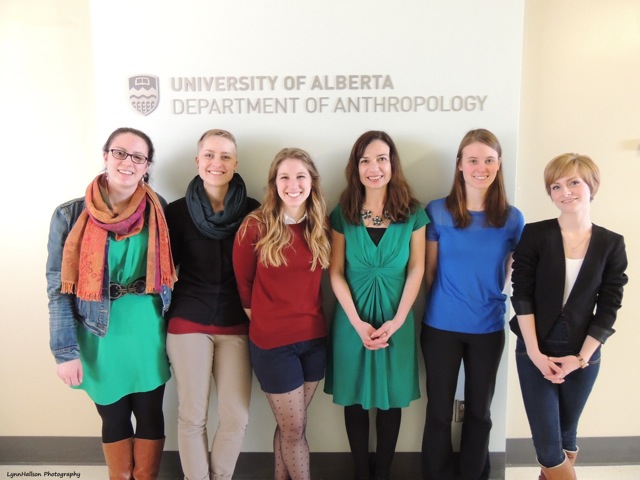 Here is the graduating Honours Anthropology class of 2014 (from left to right): Shaina Humble, Michaela Stang, Monique Neilson, Dr. Helen Vallianatos, Jen Hallson, Kassy Pointer.
Here is the graduating Honours Anthropology class of 2014 (from left to right): Shaina Humble, Michaela Stang, Monique Neilson, Dr. Helen Vallianatos, Jen Hallson, Kassy Pointer.All of the students did a wonderful job on their research projects! Their independent research projects highlight the breadth of anthropological research, across subdisciplines. Furthermore, these projects have interesting possible applications beyond their theoretical contributions. Shaina's research involved examining archives (Record Group (RG) 10 (Black Series)) in relation to Dan Cranmer's (Kwakwaka'wakw) potlatch in 1921 and continuing until 1951 when Section 149, the section of the Indian Act that outlawed the potlatch, was dropped. Michaela employed an interdisciplinary approach, using ethnographic comparison and a linguistic onomasiological comparison to look at the domain of hide-related concepts in Dene language communities, particularly among several Athapaskan language groups found along the Rocky Mountain Range (such as Gwich'in, Kaska, Tsuu T'ina, Dene Sųłiné, and Ahtna) into the American Southwest (Apache and Navajo). Monique's research explored the selective pressures influence human pelvis, with a consideration on how modern technologies (i.e. Caesarian sections) may affect contemporary and future pelvis morphology, and allowed her to hypothesize about potential evolutionary implications for human populations. Jen's research employed mapping software to reconstruct an archaeological site and in turn make density calculations and estimate the total number of artifacts that could be present at the site. Her findings allowed her to make inferences about the population, their artifact discard practices, and the demographic structure of the group. Kassy's bioanthropological research involved preparing human bone to compare the histological differences after being burned at different temperatures. Congratulations!